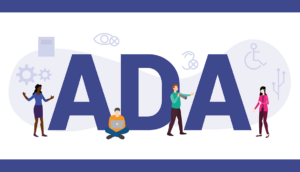If you want your website to perform like an asset, and not a liability, then you need to know more about ADA compliance and what it means for your business.
Failure to comply with requirements can result in a lengthy lawsuit and fines upward of $110,000.
However, if your website is up-to-date and in compliance with all ADA requirements, then you’re not only saving yourself the heartache of cutting a hefty check – you’re also allowing people with all types of disabilities fair and free access to the information your website has to offer.
And that’s a good thing, right?
Before I show you how to do that, we need to zoom out and learn more about what we’re talking about.
What is the ADA, exactly?
In 1990, the Americans with Disabilities ACT (ADA) was signed into law. It was a monumental moment for people living with disabilities – providing them equal rights and opportunities that had not existed previously.
So…how does a 33 year old law affect your business, more specifically your website, today?
Well, since 1996 the Department of Justice (DOJ) has taken the position that ADA applies to websites and web content.
Meaning what, exactly?
Think of it this way…
Just as a physical barrier (think steps-only at an entrance) can dissuade and prevent people from entering a building, so too can a digital barrier prevent people from freely accessing information.
Unfortunately, your website could play a part in creating this unfortunate scenario. A few digital barriers to consider…
- Lack of captions on videos
- Poor color contrast
- Information conveyed via color alone
- Lack of or no “Alt Text” options on images
- “Mouse-only” navigation & lack of keyboard option
All of these can lead to a user feeling frustrated, alienated, and unable to navigate your website.
Along with negative user experience, there are some unfortunate monetary consequences to consider as well.
Let’s talk numbers for a second…
Failure to comply with ADA requirements can result in…
- A lengthy, budget-draining lawsuit
- Fines up to $55,000 for the first violation, and up to $110,000 for a second violation
- Having to re-build your website from scratch
With the rise in ADA lawsuits over the last decade, many businesses are beginning to see that while yes – it’s best to avoid a huge ding on your balance sheet – it’s also beneficial to have a website that is compliant with all the pertinent regulations.
And also allows everyone equal access to their online information and services.
But how do you know if your website checks all the boxes?
Meeting the ADA Standards
Having an audit performed on your website by a qualified professional is your best option.
However, there is a set of guidelines that show you the components your website needs in order to be ADA compliant.
The Web Content Accessibility Guidelines (WCAG) are the standards by which compliance is measured. They’re broken down into four (4) core principles:
- Be perceivable
- Be operable
- Be understandable
- Be robust
While there are additional components to consider within each, these principles are the guiding light detailing what your website needs to include.
See for Yourself
Having trouble deciphering if your website meets the criteria needed to be ADA compliant?
No problem.
We’re able to review your website (or build you a new one) that not only makes sure you’re in full compliance, but gives your website visitors a wonderful user experience. Speaking of which…
Want to see something cool? See that little round, blue button on the bottom left side of your screen?
Give that a tap, and take a look at all the options an ADA compliant website can give you.
Need one for yourself? Contact us here to start building.
Best wishes,
Nathan Keech
Owner, KreativHQ





